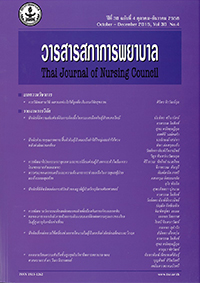ปัจจัยเสี่ยงต่อการใช้เครื่องช่วยหายใจนานในผู้ป่วยหลังผ่าตัดช่องท้อง ระยะวิกฤต
Keywords:
การผ่าตัดช่องท้อง, ระยะเวลาการใช้เครื่องช่วยหายใจ, ปัจจัยเสี่ยงการใช้เครื่อง, ช่วยหายใจนาน, abdominal surgery, length of use of mechanical ventilators, risk factors in prolonged use of mechanical ventilatorsAbstract
บทคัดย่อ: วัตถุประสงค์ของการวิจัย: เพื่อศึกษาอุบัติการณ์และปัจจัยเสี่ยงต่อการใช้เครื่อง ช่วยหายใจนาน ในผู้ป่วยหลังผ่าตัดช่องท้อง
การออกแบบวิจัย: การศึกษาเปรียบเทียบโดยติดตามไปข้างหน้า
การดำเนินการวิจัย: กลุ่มตัวอย่างคือผู้ป่วยที่เข้ารับการผ่าตัดช่องท้องที่ไม่ได้เกิดจาก อุบัติเหตุ ได้รับยาระงับความรู้สึกทั่วร่างกาย รับการรักษาในไอซียู ของโรงพยาบาล มหาวิทยาลัย แห่งหนึ่ง จำนวน 90 คน เปรียบเทียบร้อยละของตัวแปรกับระยะเวลาใช้เครื่องช่วยหายใจ โดยใช้ สถิติไคว์สแควร์และการทดสอบฟิชเชอร์ เอกแซค (Fisher exact test) กำหนดระดับนัยสำคัญที่ ระดับ 0.05 หาขนาดความสัมพันธ์โดยใช้การประมาณค่า Odd ratio
ผลการวิจัย: พบว่า ผู้ป่วยส่วนใหญ่เป็นเพศชาย (53.3%) อายุเฉลี่ย 61.29 ปี (SD + 16.64ปี) ผู้ป่วยร้อยละ 60 ใช้เครื่องช่วยหายใจนานกว่า 24 ชั่วโมง ปัจจัยที่ทำให้ใส่เครื่องช่วยหายใจนาน ได้แก่ มีภาวะระบบไหลเวียนโลหิตล้มเหลวก่อนผ่าตัด) (OR = 5.95) มีภาวะแทรกซ้อนหลังผ่าตัด ระยะแรก (OR = 5.2)ไม่ได้รับการสอนก่อนผ่าตัด (OR = 4.46, 95%CI = 1.67– 11.92, p = 0.002) มีภาวะการไหลเวียนไม่คงที่ระหว่างการผ่าตัด (OR = 3.5) มีภาวะพร่องโภชนาการก่อนผ่าตัด (OR = 3.31) และการผ่าตัดหน้าท้องส่วนบน (OR = 2.95)
ข้อเสนอแนะ: ก่อนการผ่าตัดผู้ป่วยทุกคนควรได้รับการประเมินภาวะโภชนาการ แก้ไขภาวะ ไหลเวียนโลหิตล้มเหลว ด้วยความรวดเร็ว และได้รับการสอนก่อนผ่าตัด ควรมีการเฝ้าระวังเป็นพิเศษ ในผู้ป่วยที่มีความไม่คงที่ของระบบการไหลเวียน ระหว่างการผ่าตัด มีภาวะแทรกซ้อนหลังผ่าตัด และได้รับการผ่าตัดช่องท้องส่วนบน
Abstract: Objective: To study the incidence and risk factors in prolonged use of mechanical ventilators in post-operative abdominal surgery patients.
Design: Prospective cohort study.
Implementation: The subjects were 90 patients who had undergone non-accident-related abdominal surgery. The subjects, who had been administered general anaesthesia, were being treated in the intensive care unit of a campus hospital in Bangkok. The percentage of the variables and the length of use of mechanical ventilators were compared using chi-square statistics and Fisher Exact Test, with the level of significance set at 0.05. The degree of correlation was determined using odd-ratio estimation.
Results: The majority of the subjects were male (53.3%) averagely aged 61.29 (SD ±16.64). Sixty percent of the subjects had been on mechanical ventilators for more than 24 hours. The main reasons for such prolonged use of mechanical ventilators were pre-operative haemodynamic instability (OR = 5.95), first-stage post-operative complications (OR = 5.2), lack of pre-operative teaching (OR = 4.46, 95% CI = 1.67 –11.92, p = 0.002), intra-operative haemodynamic instability (OR = 3.5), poor nutritional status prior to surgery (OR = 3.31), and upper abdominal surgery (OR = 2.95).
Recommendations: It is recommended that, prior to an operation, every patient undergo pre-operative nutritional support assessment, receive prompt treatment in case of preoperative shock, receive pre-operative teaching, be specially monitored during operation to ensure haemodynamic stability, and be closely observed to prevent post-operative complications in upper abdominal surgery cases.
Downloads
References
Weissman C, Klein N. Who receives postoperative intensive and intermediate care? J Clin Anesth. 2008;20:263–70.
Karakurt Z, Fanfulla F, Ceriana P, Carlucci A, Grassi M, Colombo R, et al. Physiologic determinants of prolonged mechanical ventilation in patients after major surgery. J Crit Care 2012;27: 221.e9–.e16.
Langeron O, Carreira S, Sache´ Fl, Raux M. Postoperative pulmonary complications updating Ann FrAnesthReanim. 2014; 33 (7):480-3.
Yamashita S, Yamaguchi H, Sakaguchi M, Yamamoto S, Aoki K, Shiga Y, et al. Effect of smoking on intraoperative sputum and postoperative pulmonary complication in minor surgical patients. Resp Med. 2004;98:760–6.
Yap, C.-H., Mohajeri, M., & Yii, M. Obesity and early complications after cardiac surgery. Med JAust. 2007; 186(7): 350–4.
Barbalho-Moulim MC, Miguel GPS, Forti EMP, Campos FvdA, Costa D. Effects of preoperative inspiratory muscle training in obese women undergoing open bariatric surgery: respiratory muscle strength, lung volumes, and diaphragmatic excursion. Clinics. 2011;66(10):1721-7.
Mohil RS, Agarwal A, Singh N, Arora J, Bhatnagar D. Does nutritional status play a role in patients undergoing emergency laparotomy. Eur E-Journal ClinNutr Met. 2008; 3 e226-e31.
Johnson RG, Arozullah AM, Neumayer L, Henderson WG, Hosokawa P, Khuri SF. Multivariable predictors of postoperative respiratory failure after general and vascular surgery: results from the patient safety in surgery study. J Am Col Surg. 2007;204(6):1188-98.
Vargas CM, Obisesan T, Gillum RF. Association of serum albumin concentration, serum ionized calcium concentration, and blood pressure in the third national health and nutrition examination survey. J Clin Epi. 1998;51(9):739–46.
Poungkamon Krisanabud, Orapan Thosingha, Suporn Danaidutsadeekul, Cherdsak Iramaneerat. Factors associated with recovery among patients undergoing non-traumatic general abdominal surgery within one week. J Thai Nurs Coun; 2012; 27 (1):39-48.
Zighelboim I, Kizer N, Taylor NP, Case AS, Gao F, Thaker PH, et al. Surgical Apgar Score predicts postoperative complications after cytoreduction for advanced ovarian cancer. GynecolOncol. 2010; 116:370–3.
Smith PR, Baig MA, Brito V, Bader F, Bergman MI, Alfonso A. Postoperative pulmonary complications after laparotomy. Respiration. 2010;80:269–74.
Dindo D, Demartines N, Clavien P-A. Classification of surgical complications a new proposal with evaluation in a cohort of 6,336 patients and results of a survey. Ann Surg. 2004;240(2): 205-13 .
Rodrigues, P., Neto, E. C., Santos, L., & Knibel, M. Ventilator-associated pneumonia: epidemiology and impact on the clinical evolution of ICU patients. J Bras Pneumol. 2009; 35(11):1084-91.
Danchaivijitr S, Dhiraputra C, Santiprasitkul S, Judaeng T. Prevalence and Impacts of Nosocomial Infection in Thailand 2001. J Med Assoc Thai. 2005;88(Suppl 10):S1-9.
Li Q, Yao G, Ge Q, Yi M, Gao J, Xi Z. Relevant risk factors affecting time of ventilation during early postoperative period after orthotopic liver transplantation. J Cri care. 2010;25: 221–4.
Bernier, M. J., Sanares, D. C., Owen, S. V., & Newhouse, P. L. Preoperative teaching received and valued in a day surgery setting. Association of Operating Room Nurses. AORN Journal. 2003; 77(3): 563-82.
Faenza S, Ravaglia MS, Cimatti M, Dante A, Spedicato S, Labate AMM. Analysis of the causal factors of prolonged mechanical ventilation after orthotopic liver transplant. Transplantation Proceedings. 2006;38:1131-4.
Engle J, Safi HJ, III CCM, Campbell MP, Harlin SA, Letsou GV, et al. The impact of diaphragm management on prolonged ventilator support after thoraco abdominal aortic repair. J Vas Surg. 1999; 29(1):150-6.








